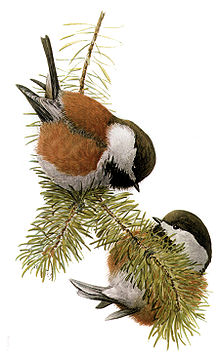|
Chestnut-backed chickadee
The chestnut-backed chickadee (Poecile rufescens) is a small passerine bird in the tit family, Paridae, native to western North America. TaxonomyIn the early 20th century, Joseph Grinnell hypothesized that the chestnut-backed chickadee diverged from the boreal chickadee (Poecile hudsonicus), because both species inhabited similar coniferous forest environments. Grinnell noted that the main differences between the boreal chickadee and the chestnut-backed were in the shade and tone of their respective brown coloration. He drew parallels between the varied chickadee characteristics using the fact that some bird species become smaller and more vibrantly brown as their habitat becomes more humid.[2] Modern molecular phylogenetic studies have confirmed that the chestnut-backed chickadee is sister to the boreal chickadee.[3][4][5] More recent research regarding the population distribution of the chestnut-backed chickadee suggests that the genetic fragmentation of the chestnut-backed chickadee from the boreal chickadee was due to the changing glacial landscapes of the Pleistocene era.[6] After this species divergence, the chestnut-backed chickadee migrated south to inhabit the range described above. SubspeciesThere are three subspecies, with the flanks being grayer and less rufous further south:[7]
In addition to these three subspecies, research on the geographical range of chestnut-backed chickadees suggests that there are also four "genetically distinct" groups of chestnut-backed chickadee in North America. Including the populations in Alaska and Coastal North America, there are also separate populations inhabiting the Queen Charlotte islands and British Columbia.[6] In fact, the chestnut-backed chickadee is the only species of chickadee that resides on the British Columbia islands.[6] Distribution and habitatIt is found in the Pacific Northwest of the United States and western Canada, from southeastern Alaska to southwestern California. Its geographical range hugs the humid, foggy coasts. It is a permanent resident within its range, with some seasonal movements as feeding flocks move short distances in search of food. These chickadees usually move to lower elevations in the same area upon onset of winter and move back up to higher elevations in late summer. Its habitat is low elevation coniferous and mixed coniferous forests, consisting mainly of Douglas fir, western hemlock, and western redcedar.[8] This environment provides plenty of shade and constant, cool temperature.[2] In fact, the abundance of Douglas fir trees can be a helpful indicator for the population of chestnut-backed chickadees in the region.[6] In the San Francisco Bay Area, this bird has readily adapted to suburban settings, prompting expansion farther inland.[citation needed] DescriptionIt is a small chickadee, 11.5–12.5 cm (4.5–4.9 in) long with a weight of 8.5–12.6 g (0.30–0.44 oz). The head is dark blackish-brown with white cheeks, the mantle is bright rufous-brown, the wing feathers are dark gray with paler fringes. The underparts are white to pale grayish-white, with rufous or pale gray flanks. It is often considered the most vibrant of all chickadees.[9] Chickadees are able to use nocturnal hypothermia to regulate energy expenditure, allowing them to survive harsh winters where other bird species not utilizing thermal regulation would not be able to. Some estimates put the energy conserved while using nocturnal hypothermia all the way up to 32%.[10] Diet and foragingChestnut-backed chickadees feed largely on insects and other invertebrates gleaned from foliage (especially from that of the Douglas fir). They often move through the forest in mixed feeding flocks, and can be spotted in large groups with bushtits, warblers, red-breasted nuthatches, and kinglets. Chestnut-backed chickadees also eat seeds and plant matter, especially those of conifers, and fruit. It will visit bird feeders, including hummingbird feeders, and especially loves suet.[8] Mating and nestingChestnut-backed chickadees mate monogamously, and can stay with the same partner for years.[8] These chickadees are cavity-nesters, preferring tree-stump holes and nest boxes, usually utilizing an abandoned woodpecker hole, but sometimes excavating on their own. During nesting season, the female chickadee will spend about a week building the nest on her own. She builds the under layers of the nest from moss and tree bark, with layer of fur on top.[8] Chestnut-backed chickadees use much fur and hair to make their nests. Their nests are actually 50% fur and hair. The most common hair they use comes from deer, rabbits, and coyotes. The adult chickadees also make a layer of fur about a centimeter thick which is used to cover the eggs on the nest whenever they leave the nest. The female lays 5–8 (sometimes 9) eggs per clutch, laying about one egg each morning. Weasels are the main predator risk posed to chestnut chickadee eggs. The incubation period is about two weeks, and the chicks fledge the nest about three weeks after hatching.[8] Gallery
References
External linksWikimedia Commons has media related to Poecile rufescens. Wikispecies has information related to Poecile rufescens.
|
||||||||||||||||||||||||||||||||||||||||





